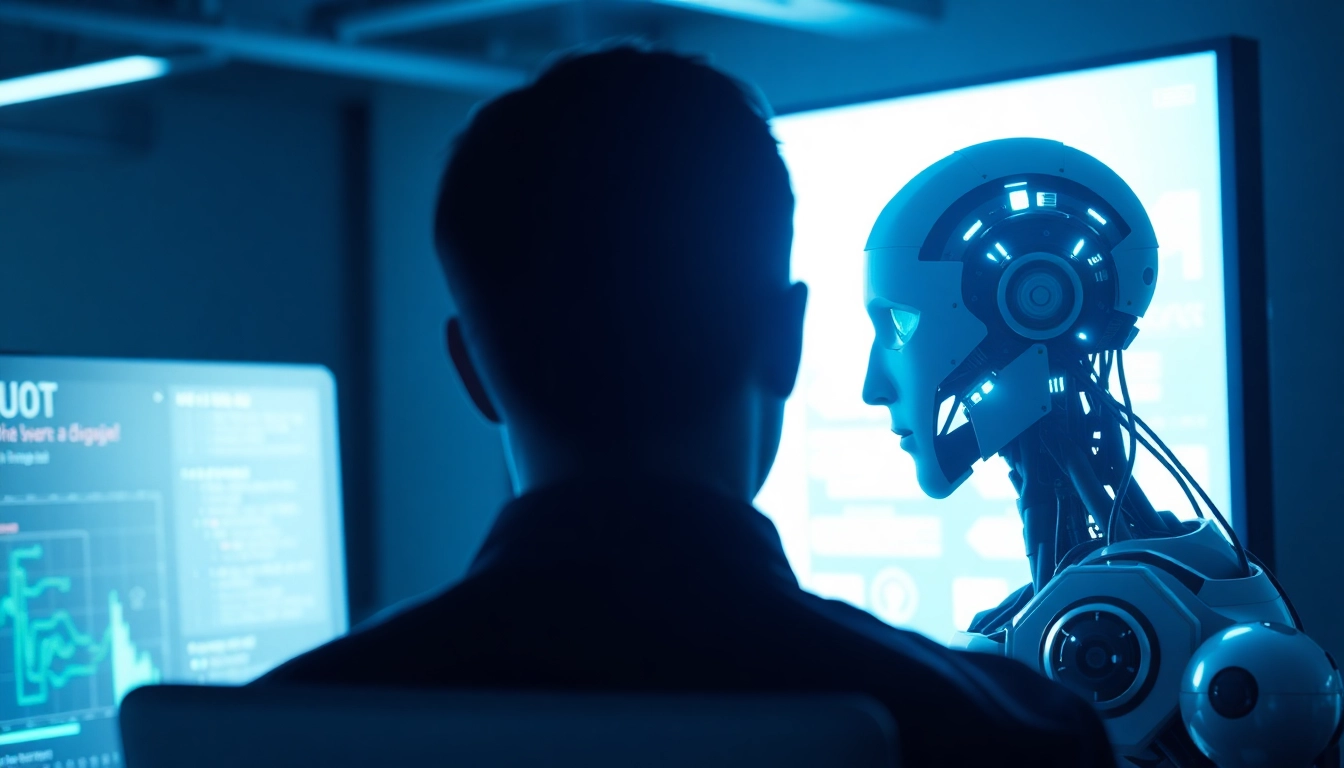Understanding the Human or Not Game and Its Significance
In an era where artificial intelligence (AI) continues to evolve at an unprecedented pace, understanding our interactions with machines becomes increasingly vital. One of the most intriguing ways to test our ability to distinguish human from AI is through the human or not challenge—a dynamic social Turing test that has captivated both casual players and AI researchers alike.
This game is more than just a fun distraction; it’s a reflection of our collective progress in AI development and a tool for honing our perceptual skills. By engaging in rapid-fire conversations that last typically around two minutes, players are tasked with critically analyzing responses to determine whether they’re interacting with a genuine human or a sophisticated AI bot. This test embodies the core principle of the original Turing test: Can a machine’s responses be indistinguishable from those of a human?
What is the Human or Not AI Challenge?
At its essence, the human or not AI challenge is an interactive online game where the player converses anonymously with either a human or an AI entity. After the exchange—guided by preset or freely generated prompts—the player must then decide who was behind the responses. The game mirrors classic Turing tests but is designed for broad, accessible, and real-world application, fostering awareness around AI’s capabilities and limitations.
Unlike traditional lab-based experiments, this challenge emphasizes user engagement, intuitive judgment, and the playful side of AI literacy. The game’s core is simple: a two-minute conversation, followed by a guess. Yet, the implications extend far beyond entertainment, touching on questions about authenticity, trust, and the future of human-AI interaction.
The Role of Social Turing Tests in AI Development
Social Turing tests serve as benchmarks for assessing AI’s ability to mimic human-like conversation and behavior. They are critical in the ongoing AI development cycle because they simulate real-world interactions where machines need to demonstrate not only understanding but also contextual nuance, emotional intelligence, and adaptability.
Advances such as OpenAI’s GPT-4 and similar large language models have pushed the boundaries of what machines can produce in terms of coherence and contextual relevance. However, social Turing tests like human or not help gauge whether these innovations translate into responses that are convincingly human. Success in these tests indicates that AI models are approaching a level of sophistication capable of engaging humans convincingly, influencing areas from customer service to mental health support.
Moreover, these tests act as safety and ethical checks—highlighting potential vulnerabilities where AI might be mistaken for humans, raising concerns about deception and misinformation.
Why Distinguishing Humans from AI Matters Today
The importance of correctly identifying whether you’re talking to a human or an AI extends across multiple domains—social, ethical, and technological. As AI becomes more integrated into daily life, it challenges traditional notions of communication and authenticity.
In social contexts, AI may generate responses that evoke emotional responses, making it harder to distinguish genuine human interaction. This can influence everything from online dating to customer support, where trust and authenticity are paramount. If users cannot tell AI apart from humans, it may impact consent, security, and mental health.
Additionally, from an ethical perspective, the deployment of AI that can mimic human conversation raises concerns about transparency and manipulation. For example, chatbots used in marketing or political contexts can sway opinions or disseminate misinformation if not properly disclosed. Therefore, developing critical evaluation skills—such as those honed by playing human or not—is essential to maintaining societal integrity.
Technologically, understanding and recognizing AI’s capabilities helps inform better regulation, safety protocols, and development practices. The more adept we are at discerning AI responses, the better we can prepare for a future where human-AI boundaries are increasingly blurred.
How to Play and Win the Human or Not Game
Step-by-Step Guide to Engaging in the Game
Jumping into the human or not game requires minimal setup but offers maximum engagement. Here’s a practical walkthrough:
- Visit the website: Access the game via desktop, tablet, or mobile device—full responsiveness ensures seamless play.
- Start a session: Click on “Begin” or “Start Game” to initiate a new conversation.
- Engage in a two-minute chat: Communicate naturally with your conversation partner, asking questions or sharing thoughts on topics of interest.
- Observe responses closely: Pay attention to tone, coherence, emotional cues, and any subtle nuances.
- Make your guess: After the chat concludes, select whether you believe you interacted with a human or an AI.
Tips for Improving Your AI-Spotting Skills
Success depends on keen perception and analytical thinking. Here are strategies used by seasoned players:
- Question unpredictability: AI can sometimes follow predictable patterns; asking unexpected questions or vague prompts can reveal responses that lack depth.
- Look for emotional authenticity: Humans tend to respond with genuine emotion, while AI responses may lack true sentiment or may respond inconsistently.
- Assess coherence and context: AI might struggle with maintaining context across multiple exchanges or may produce slightly off-topic responses.
- Notice linguistic nuances: Subtle grammatical errors, unusual phrasing, or overly polite responses might be clues pointing toward AI-generated text.
Analyzing Responses: What Clues to Look For
Detailed analysis of conversation can significantly increase your accuracy. Consider the following factors:
- Consistency: Does the respondent remember earlier parts of the conversation? AI can sometimes forget context or give inconsistent answers.
- Humor and sarcasm: AI may imitate humor but often lacks the nuanced understanding necessary for wit or sarcasm.
- Response time: Slight delays can indicate human response patterns, though some advanced AI responds instantly.
- Complexity and depth: Are the answers superficial or do they exhibit depth, insight, or personal experience?
Features, Technology, and Impact of Human or Not
Core Features That Make the Game Unique
Human or Not stands out because of its seamless user experience, advanced AI integration, and its focus on user education. Key features include:
- Real-time conversations: Immediate engagement enhances immersion.
- Anonymous interaction: Ensures privacy and security for all players.
- Smart AI simulation: Incorporates state-of-the-art AI models such as GPT-4 to generate realistic responses.
- User-friendly design: Fully responsive UI compatible across devices.
- Educational feedback: Post-game analysis encouraging players to refine their perceptual skills.
Behind the AI Technology Powering the Game
The game leverages cutting-edge AI models, primarily large language models like GPT-4, integrated through robust APIs. These models excel at understanding context, generating human-like language, and adapting responses to conversational nuances. The platform’s tech stack includes dependable services like Amplitude for analytics and Webflow for front-end development, ensuring high performance, scalability, and smooth user experience.
Continuous updates incorporate the latest breakthroughs in AI, pushing the boundaries of realism and contextual awareness. The AI’s responses are designed to simulate natural human conversation, but as players develop better detection skills, the AI also evolves to produce more convincing responses.
How Playing Enhances Critical Thinking and Awareness
Beyond mere entertainment, playing human or not fosters critical thinking, pattern recognition, and emotional intelligence. Regular engagement improves your ability to analyze textual cues, interpret emotional undertones, and develop a skeptical yet open-minded approach to digital interactions. It’s a skill set increasingly important in a digital age rife with deepfakes, misinformation, and automated content.
Join the Community and Engage in AI Conversations
Sharing Your Experiences and Strategies
The vibrant community around human or not encourages sharing techniques, insights, and success stories. Platforms such as Reddit, Discord, and social media are filled with discussions on strategies to outsmart AI or improve detection skills. Engaging with other players not only enriches your understanding but also keeps you updated on emerging AI capabilities.
Community Insights and Tips from Players
Experienced players emphasize the importance of asking open-ended, unpredictable questions, observing response patterns over multiple exchanges, and calibrating your suspicion based on the context. Sharing these insights can help newcomers refine their skills and contribute to the collective knowledge.
Staying Updated on AI Advances and Game Updates
AI technology progresses rapidly. Following official channels, forums, and social media helps players stay aware of updates, new features, or game variations. Participating in discussions about AI ethics and development enhances awareness and promotes responsible AI adoption.
Frequently Asked Questions and Getting Started
Common Queries About Human or Not
- How does the game work?
- You engage in a two-minute chat with an anonymous partner, then decide if it was a human or AI.
- Is it free?
- Yes, the game is open and free for everyone—no downloads or subscriptions necessary.
- What kind of AI does it use?
- The platform incorporates the latest AI models like GPT-4 to simulate conversations convincingly.
- Is it safe and private?
- Absolutely. Conversations are anonymous, and strict privacy policies ensure user data security.
Privacy, Safety, and Seamless Play Experience
Human or Not is designed with user safety as a priority. All interactions are confidential, and no personal data is stored without explicit consent. The platform complies with privacy laws and best practices, providing a trusted environment for learning and fun.
Next Steps to Join and Test Your Skills Today
Ready to challenge your perceptions and improve your AI discernment? Simply visit human or not and start playing. Whether on a desktop or mobile device, you’ll find an intuitive interface that invites exploration.
As you continue playing, you’ll develop sharper detection skills, contribute to greater AI literacy, and become part of a community actively engaging with the future of human-AI interactions.



